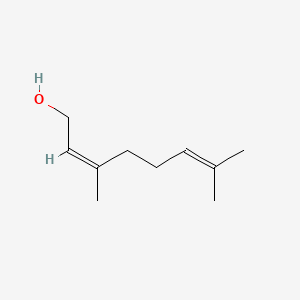| Authors | Title | Published | Journal | PubMed Link |
|---|---|---|---|---|
| Keung WM | Human liver alcohol dehydrogenases catalyze the oxidation of the intermediary alcohols of the shunt pathway of mevalonate metabolism. | 1991 | Biochem. Biophys. Res. Commun. | pmid:1993065 |
| Chattopadhyay A et al. | PQQ-dependent alcohol dehydrogenase (QEDH) of Pseudomonas aeruginosa is involved in catabolism of acyclic terpenes. | 2010 | J. Basic Microbiol. | pmid:20082374 |
| Spiller M et al. | Genetic dissection of scent metabolic profiles in diploid rose populations. | 2010 | Theor. Appl. Genet. | pmid:20084491 |
| George DR et al. | Toxicity of geraniol solution in vitro to the poultry red mite, Dermanyssus galinae. | 2009 | Parasite | pmid:20092065 |
| Gilpin S et al. | In vitro human skin penetration of geraniol and citronellol. | 2010 Jan-Feb | Dermatitis | pmid:20137738 |
| Zore GB et al. | Evaluation of anti-Candida potential of geranium oil constituents against clinical isolates of Candida albicans differentially sensitive to fluconazole: inhibition of growth, dimorphism and sensitization. | 2011 | Mycoses | pmid:20337938 |
| Miyazawa N et al. | Aroma character impact compounds in Kinokuni mandarin orange (Citrus kinokuni) compared with Satsuma mandarin orange (Citrus unshiu). | 2010 | Biosci. Biotechnol. Biochem. | pmid:20378969 |
| Jarau S et al. | Workers make the queens in melipona bees: identification of geraniol as a caste determining compound from labial glands of nurse bees. | 2010 | J. Chem. Ecol. | pmid:20431925 |
| Cardozo MT et al. | Chemopreventive effects of β-ionone and geraniol during rat hepatocarcinogenesis promotion: distinct actions on cell proliferation, apoptosis, HMGCoA reductase, and RhoA. | 2011 | J. Nutr. Biochem. | pmid:20435455 |
| HellÃn P et al. | Evolution of aroma and phenolic compounds during ripening of 'superior seedless' grapes. | 2010 | J. Agric. Food Chem. | pmid:20438135 |
| Su YW et al. | Inhibitory effects of citronellol and geraniol on nitric oxide and prostaglandin Eâ‚‚production in macrophages. | 2010 | Planta Med. | pmid:20506077 |
| pmid:20571572 | ||||
| Cuesta L et al. | Fragrance contact allergy: a 4-year retrospective study. | 2010 | Contact Derm. | pmid:20573166 |
| Swerdlin A et al. | Fragrance mix reactions and lime allergic contact dermatitis. | 2010 Jul-Aug | Dermatitis | pmid:20646673 |
| Matsuoka H et al. | Evaluation of antifungal volatile compounds on the basis of the elongation rate of a single hypha. | 1990 | Appl. Environ. Microbiol. | pmid:2082824 |
| Müller GC et al. | Efficacy of the botanical repellents geraniol, linalool, and citronella against mosquitoes. | 2009 | J. Vector Ecol. | pmid:20836800 |
| Paroul N et al. | Solvent-free geranyl oleate production by enzymatic esterification. | 2011 | Bioprocess Biosyst Eng | pmid:20981557 |
| Reeves WK and Miller MM | Aqueous 2% geraniol as a mosquito repellent failed against Aedes aegypti on ponies. | 2010 | J. Am. Mosq. Control Assoc. | pmid:21033064 |
| Jassbi AR et al. | Phytotoxic volatiles in the roots and shoots of Artemisia tridentata as detected by headspace solid-phase microextraction and gas chromatographic-mass spectrometry analysis. | 2010 | J. Chem. Ecol. | pmid:21086024 |
| Gonzalez-Audino P et al. | Comparative toxicity of oxygenated monoterpenoids in experimental hydroalcoholic lotions to permethrin-resistant adult head lice. | 2011 | Arch. Dermatol. Res. | pmid:21174108 |
Nerol
Nerol is a lipid of Prenol Lipids (PR) class. The involved functions are known as Odorant, Anabolism, Diastasis, Metabolic Inhibition and Oxidation. Nerol often locates in germ tube. The related lipids are Octanols, Pinene, Hexanols, ethyl butyrate and ethyl hexanoate.
Cross Reference
Introduction
To understand associated biological information of Nerol, we collected biological information of abnormalities, associated pathways, cellular/molecular locations, biological functions, related genes/proteins, lipids and common seen animal/experimental models with organized paragraphs from literatures.
What diseases are associated with Nerol?
There are no associated biomedical information in the current reference collection.
No disease MeSH terms mapped to the current reference collection.
PubChem Associated disorders and diseases
What pathways are associated with Nerol
There are no associated biomedical information in the current reference collection.
PubChem Biomolecular Interactions and Pathways
Link to PubChem Biomolecular Interactions and PathwaysWhat cellular locations are associated with Nerol?
Visualization in cellular structure
Associated locations are in red color. Not associated locations are in black.
Related references are published most in these journals:
| Location | Cross reference | Weighted score | Related literatures |
|---|
What functions are associated with Nerol?
Related references are published most in these journals:
| Function | Cross reference | Weighted score | Related literatures |
|---|
What lipids are associated with Nerol?
Related references are published most in these journals:
| Lipid concept | Cross reference | Weighted score | Related literatures |
|---|
What genes are associated with Nerol?
There are no associated biomedical information in the current reference collection.
What common seen animal models are associated with Nerol?
There are no associated biomedical information in the current reference collection.
